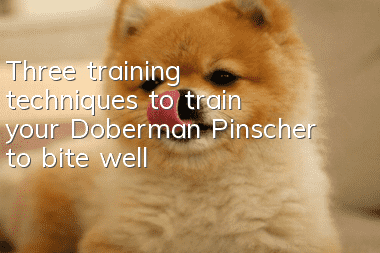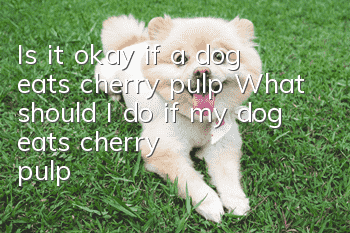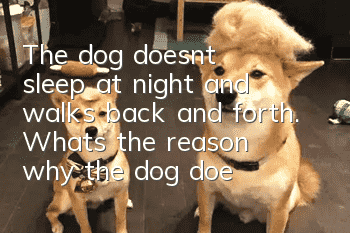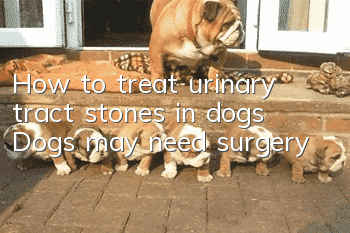Three training techniques to train your Doberman Pinscher to bite well

It is often seen that police officers bring police dogs with them when they are on duty, and whenever new discoveries are made, they are all contributed by the dogs’ sense of smell, bravery, and quick response. So how should a good Doberman be trained? Will it be caused by excessive training? What about dogs engaging in aggressive behavior? Biting is one of the instincts of dogs to protect themselves and exclude others, but this is just biting in a narrow sense. The bite of a trained dog refers to the purposeful and step-by-step training of the dog, so that it can achieve the fierce and rapid completion of the command bite based on only the instinctive bite in the narrow sense. How to do a good job in bite training for trained dogs.
1. Developing Doberman’s desire to bite
This is the basic work of bite training. It mainly lays the foundation for later training in terms of the dog's courage, bite force, physical fitness and confidence. The training environment for fighting for biting objects can be divided into inside the kennel and outside the kennel. The initial training requires keeping the environment quiet and eliminating other external interference. In terms of training items, the dog's traction tools are required to be strong and the items to be bitten should be diverse (such as towels, hemp sticks, old clothes, wooden sticks, etc.). The training at this stage should ensure that the dog has no fear of those who compete for objects, actively bites objects, and has a strong desire to win. In terms of training operations, the owner can hold silk items that the dog often picks up to fully arouse the dog's excitement and stimulate the dog's desire to hunt. When the dog shows a strong behavior of being eager to get the item, the owner will give the item to the dog to bite. And compete with the dog, and at the same time reward the dog with the command "good", you can also compete with the dog with one hand, and pat the dog with the other hand, and finally let the dog win the game of competing for items with the owner. You can also hold a hemp stick or other biting objects to guide the dog outside the kennel. When the dog shows a strong desire to bite, send one end of the hemp stick into the kennel through the gap in the kennel, and hold the other end with the dog. The dog competes, and at the same time, it can make threatening sounds or fake hitting movements to stimulate the dog, and ultimately the dog wins. Note that you should try your best to choose items that are suitable for dogs to bite and easy for people to fight over. The amount of force and duration of the fight with the dog should be determined according to the dog's actual ability, and the time and intensity of the fight should be properly controlled.
2. The development of Doberman’s ferocity and hatred
The cultivation of a dog's ferocity and hatred is a very important stage in bite training, and its main function is to cultivate the dog's motivation to bite. It can be divided into two forms of training: inside the kennel and outside the kennel. The training environment requires flat terrain, no other obstacles, and easy running and fighting between the dog and the trainer. The dog's traction tool must be firm and the trainer's protective measures must be complete. The basic indicator of training is that the dog should not be afraid of the assistant trainer's guidance and other stimulation methods, and should actively attack the dog trainer. During the training operation, place the dog's food at the inner door of the kennel, then leave and hide it in a place where the dog cannot see it. After the assistant trainer confirms that the dog has started eating, he makes a sound to attract the dog's attention and approaches with secretive movements.The kennel, pretending to compete with the dog for food. When the dog barks and scratches at the kennel, use a prepared tuning stick (either a branch or a broom) to hit the kennel, and at the same time make a threatening sound to stimulate the dog, and finally help the trainer escape. Kennel End. The assistant trainer can also draw the dog's attention by shouting or knocking on the door panel outside the door. The dog trainer brings the dog close to the door and gives the "attention" command. At this time, the assistant trainer can fit in the crack of the door and use the prepared dog A good training tool can hit the ground or the dog's body to stimulate the dog. When a dog exhibits strong aggressive behavior, the dog trainer leads the dog to retreat, and the assistant trainer enters the room to guide the dog. The dog trainer encourages the dog by patting it, and finally ends with the assistant trainer escaping from the room. The best way to train for outdoor ferocity is through group training. Before training, the dogs are divided into groups according to their ferocity. The number of dogs in each group is 5 to 8, which is more appropriate. Before the training begins, the dog handler arranges the dogs in a semi-arc shape (the distance is about 3 meters), checks the traction equipment, stands in a "T" step, and waits for the assistant trainer's guidance. At this time, the assistant trainer suddenly appears in the dog's field of vision from the hiding place, shouts loudly to attract the dog's attention, and waves the mobilization tool to jump close to the dog. After reaching the dog, he first hits the ground with the mobilization tool and intimidates him, etc. Methods are used to guide the dog, and then the stimulation method of whipping the dog's body is appropriately applied according to the individual condition of the dog. The dog trainer encourages the dog on the side, and finally the training ends with the help of the trainer to escape from the training ground.
3. Doberman bite training under short traction
The bite training under short traction is the first stage of the bite on the open sleeve. Through this stage of training, the dog can clearly understand the position of the open sleeve bite, cultivate the dog's habit of not releasing the mouth after biting, and increase its excitement to bite. sex. According to the different ways of giving sleeves by the assistant trainer, it can be divided into two types: forward giving and backward giving. It is required that the traction tool is firm, the trainer's protective equipment is complete, and the size of the bite guard must be suitable for the dog's bite. The training should be such that the dog actively bites the handler, has no fear of the handler's whipping, and does not hesitate to bite. In terms of training operations, a suitable outdoor venue can be selected. The dog trainer will make preparations before biting and then signal to the assistant trainer. The assistant trainer wears protective equipment and fully guides the dog. When the dog has a strong desire to attack, the assistant trainer should stand half a meter away from the dog with his protective sleeves raised and stand still. The dog trainer leads the dog and steps forward to bite. , when the dog bites the protective sleeve, the assistant handler swings the protective sleeve left and right to compete with the dog. At this time, the dog trainer tightens the leash and pats the dog to strengthen it, so that the dog trainer forces the dog to let go of the protective sleeve. The assistant trainer ends the training by guiding the dog again. During the front-facing sleeve-giving training, the assistant trainer fully guides the dog about 10 meters away from the dog, approaches the dog in an outer arc running route, and when he reaches the dog, he takes advantage of the situation and delivers the protective sleeve to the dog. At this time, , the dog handler should relax the traction on the dog in time, so that the dog can jump up and bite the assistant handler. After the dog bites the protective sleeve, the assistant handler swings the protective sleeve left and right to fight with the dog, and the dog trainer forces the dog to let go.Protect the sleeves, and then the assistant trainer will guide the dog again to end the training. In the back-and-sleeve training, the assistant trainer fully guides the dog about 2 to 3 meters away from the dog, and then runs away from the dog. At this time, the dog handler pulls the dog to follow quickly. When the dog is close to the target, the assistant trainer slows down the running speed, raises the protective sleeve and lets the dog bite. After the dog bites the protective sleeve, the assistant trainer swings the protective sleeve left and right and the dog Fight for it, and at the same time use the whip to hit the guard sleeve or the dog's body to stimulate the dog's desire to bite. The dog trainer forces the dog to let go of the protective sleeve, and the assistant trainer guides the dog again to end the training. Pay attention to the coordination between the assistant trainer and the dog handler, and can use words or gestures for necessary communication. The trainer's external stimulation to the dog should not be too great, otherwise the dog will be prone to slow mouth.
- What should I do if my dog has no milk? The owner should check quickly and don’t let the puppies starve to death.
- Dog’s anal gland odor, please note that this is a sign of your dog’s health!
- How to make your dog like to eat dog food Four ways to make your dog fall in love with dog food
- Can dogs digest peach pits if they eat them? Can dogs digest peach pits if they accidentally eat them?
- How to protect your dog’s food? Teach you tips on training your dog
- Why do dogs defecate everywhere? How can dogs stop defecating everywhere?
- What should I do if my dog has lupus? Immune system diseases should not be underestimated
- If your dog's hair is cut and the skin is cut, the flesh is exposed. If the dog's hair is accidentally cut and the skin is cut, it must be disinfected immediately.
- Do dogs need deworming in summer? What should you pay attention to when raising dogs in summer?
- What to do if your dog has indigestion? Dog indigestion is no small matter!



